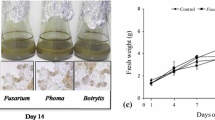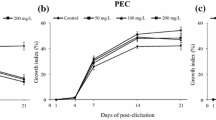Abstract
Hypericum perforatum L. cell suspensions were evaluated for their growth, antioxidant activity, phenolic compound productions and xanthone profile after elicitation with Agrobacterium tumefaciens and Agrobacterium rhizogenes. Secondary metabolite production in H. perforatum elicited cells was enhanced without loss of biomass. A. tumefaciens elicited cells showed largely increased amounts of total phenolics and flavonoids, whereas total flavanol contents were slightly enhanced. The production of phenolic compounds was clearly less marked in A. rhizogenes treated cells. Antioxidant activity of elicited cells was remarkably elevated throughout the post-elicitation period. A significant correlation between antioxidant activity and phenolic production in elicited cells was found. Xanthone profile of H. perforatum cells was notably changed after bacterial elicitation. H. perforatum elicited cells yielded about 17-fold higher levels of xanthones compared to control cells. Among the twenty-one detected xanthones, five of them identified as 1,3,5,6-tetrahydroxyxanthone C-prenyl isomer, toxyloxanthone, 1,3,7-trihydroxy-6-methoxy-8-prenyl xanthone, 1,3,6-trihydroxy-7-methoxy-8-prenyl xanthone and 1,3,6,7-tetrahydroxyxanthone 2-prenyl xanthone were de novo synthesized in elicited cells. Altogether, these results indicated that H. perforatum cells elicited with Agrobacterium represent promising experimental system for enhanced production of xanthones.




Similar content being viewed by others
Abbreviations
- CE:
-
Catechin equivalents
- DAD:
-
Diode-array detection
- DPPH:
-
1,1-Diphenyl-2-picrylhydrazyl
- DW:
-
Dry weight
- ESI:
-
Electrospray ionization
- GAE:
-
Gallic acid equivalents
- HPLC:
-
High-performance liquid chromatography
- MS:
-
Mass spectrometry
- TP:
-
Total phenolics
- TF:
-
Total flavonoids
- TFL:
-
Total flavanols
- 2,4-D:
-
2,4-Dichlorophenoxyacetic acid
- BA:
-
N 6-benzyladenine
References
Bergonzi MC, Bilia AR, Gallori S, Guerrini D, Vincieri FF (2001) Variability in the content of the constituents of Hypericum perforatum L. and some commercial extracts. Drug Dev Ind Pharm 27:491–497
Bombardelli E, Morazzoni P (1995) Hypericum perforatum. Fitoterapia 66:43–68
Brand-Williams W, Cuvelier ME, Berset C (1995) Use of a free radical method to evaluate antioxidant activity. LWT Food Sci Technol 28:25–30
Breyer A, Elstner M, Gillessen T, Weiser D, Elstner E (2007) Glutamate-induced cell death in neuronal HT22 cells is attenuated by extracts from St. John’s wort (Hypericum perforatum L.). Phytomedicine 14:250–255
Chodisetti B, Rao K, Gandi S, Giri A (2013) Improved gymnemic acid production in the suspension cultures of Gymnema sylvestre through biotic elicitation. Plant Biotechnol Rep 7:519–525
Conceição LFR, Ferreres F, Tavares RM, Dias ACP (2006) Induction of phenolic compounds in Hypericum perforatum L. cells by Colletotrichum gloeosporioides elicitation. Phytochemistry 67:149–155
Cui XH, Murthy HN, Wu CH, Paek KY (2010) Sucrose-induced osmotic stress affects biomass, metabolite, and antioxidant levels in root suspension cultures of Hypericum perforatum L. Plant Cell Tiss Org 103:7–14
Cuyckens F, Rozenberg R, Hoffmann E, Claeys M (2001) Structure characterization of flavonoid O-diglycosides by positive and negative nano-electrospray ionization ion trap mas spectrometry. J Mass Spectrom 36:1203–1210
Danova K, Čellárová E, Macková A, Daxnerová Z, Kapchina-Toteva V (2010) In vitro culture of Hypericum rumeliacum Boiss. and production of phenolics and flavonoids. In Vitro Cell Dev Biol Plant 46:422–429
Dias ACP, Seabra RM, Andrade PB, Ferreres F, Fernandes-Ferreira M (2000) Xanthone biosynthesis and accumulation in calli and suspended cells of Hypericum androsaemum. Plant Sci 150:93–101
Dias ACP, Seabra RM, Andrade PB, Ferreres F, Ferreira MF (2001) Xanthone production in calli and suspended cells of Hypericum perforatum. J Plant Physiol 158:821–827
Erbs G, Silipo A, Aslam S, De Castro C, Liparoti V, Flagiello A, Pucci P, Lanzetta R, Parrilli M, Molinaro A, Newman M-A, Cooper RM (2008) Peptidoglycan and muropeptides from pathogens Agrobacterium and Xanthomonas elicit plant innate immunity: structure and activity. Chem Biol 15:438–448
Fotie J, Bohle DS (2006) Pharmacological and biological activities of xanthones. Anti Infect Agents Med Chem 5:15–31
Franklin G, Conceição LFR, Kombrink E, Dias ACP (2008) Hypericum perforatum plant cells reduce Agrobacterium viability during co-cultivation. Planta 227:1401–1408
Franklin G, Conceição LFR, Kombrink E, Dias ACP (2009) Xanthone biosynthesis in Hypericum perforatum cells provides antioxidant and antimicrobial protection upon biotic stress. Phytochemistry 70:60–68
Gadzovska S, Maury S, Ounnar S, Righezza M, Kascakova S, Refregiers M, Spasenoski M, Joseph C, Hagège D (2005) Identification and quantification of hypericin and pseudohypericin in different Hypericum perforatum L. in vitro cultures. Plant Physiol Biochem 43:591–601
Gadzovska S, Maury S, Delaunay A, Spasenoski M, Joseph C, Hagege D (2007) Jasmonic acid elicitation of Hypericum perforatum L. cell suspensions and effects on the production of phenylpropanoids and naphtodianthrones. Plant Cell Tiss Org 89:1–13
Gadzovska S, Maury S, Delaunay A, Spasenoski M, Hagège D, Courtois D, Joseph C (2013) The influence of salicylic acid elicitation of shoots, callus, and cell suspension cultures on production of naphtodianthrones and phenylpropanoids in Hypericum perforatum L. Plant Cell Tiss Org 113:25–39
Gadzovska-Simic S, Tusevski O, Antevski S, Atanasova-Pancevska N, Petreska J, Stefova M, Kungulovski D, Spasenoski M (2012) Secondary metabolite production in Hypericum perforatum L. cell suspensions upon elicitation with fungal mycelia from Aspergillus flavus. Arch Biol Sci 64:113–121
Gamborg OL, Miller RA, Ojima K (1968) Nutrient requirements of suspension cultures soybean root cells. Exp Cell Res 50:148–151
Gelvin SB (2003) Agrobacterium-mediated plant transformation: the biology behind the “gene-jockeying” tool. Microbiol Mol Biol Rev 67:16–37
Ishiguro K, Fukumoto H, Nakajima M, Isoi K (1993) Xanthones in cell suspension cultures of Hypericum paturum. Phytochemistry 33:839–840
Ishiguro K, Nakajima M, Fukumoto H, Isoi K (1995) Co-occurence of prenylated xanthones and their cyclization products in cell suspension cultures of Hypericum patulum. Phytochemistry 38:867–869
Jung HY, Kang SM, Kang YM, Kang MJ, Yun DJ, Bahk JD, Yang JK, Choi MS (2003) Enhanced production of scopolamine by bacterial elicitors in adventitious hairy root cultures of Scopolia parviflora. Enzyme Microb Technol 33:987–990
Jürgenliemk G, Nahrstedt A (2002) Phenolic compounds from Hypericum perforatum. Planta Med 68:88–91
Kirakosyan A, Hayashi H, Inoue K, Charchoglyan A, Vardapetyan H (2000) Stimulation of the production of hypericins by mannan in Hypericum perforatum shoot cultures. Phytochemistry 53:345–348
Kirakosyan A, Sirvent TM, Gibson DM, Kaufman PB (2004) The production of hypericins and hyperforin by in vitro cultures of St. John’s wort (Hypericum perforatum). Biotechnol Appl Biochem 39:71–81
Košuth J, Koperdáková J, Tolonen A, Hohtola A, Čellárová E (2003) The content of hypericins and phloroglucinols in Hypericum perforatum L. seedlings at early stage of development. Plant Sci 165:515–521
Krolicka A, Szpitter A, Gilgenast E, Romanik G, Kaminski M, Lojkowska E (2008) Stimulation of antibacterial naphthoquinones and flavonoids accumulation in carnivorous plants grown in vitro by addition of elicitors. Enzyme Microb Technol 42:216–221
Li YG, Tanner G, Larkin P (1996) The DMACA-HCl protocol and the threshold proanthocyanidin content for bloat safety in forage legumes. J Sci Food Agric 70:89–101
Lim FL, Yam MF, Asmawi MZ, Chan LK (2013) Elicitation of Orthosiphon stamineus cell suspension culture for enhancement of phenolic compounds biosynthesis and antioxidant activity. Ind Crops Prod 50:436–442
Liu FF, Ang CY, Springer D (2000) Optimization of extraction conditions for active components in Hypericum perforatum using response surface methodology. J Agric Food Chem 48:3364–3371
Makris DP, Boskou G, Andrikopoulos NK (2007) Polyphenolic content and in vitro antioxidant characteristics of wine industry and other agri-food solid waste extracts. J Food Comp Anal 20:125–132
Meruelo D, Lavie G, Lavie D (1988) Therapeutic agents with dramatic antiretroviral activity and little toxicity at effective doses: aromatic polycyclic diones hypericin and pseudohypericin. Proc Natl Acad Sci 85:5230–5234
Murashige T, Skoog F (1962) A revised medium for rapid growth and bioassays with tobacco tissue cultures. Phys Plant 15:473–497
Murch SJ, Saxena PK (2006) St. John’s wort (Hypericum perforatum L.): challenges and strategies for production of chemically consistent plants. Can J Plant Sci 86:765–771
Nahrstedt A, Butterweck V (2010) Lessons learned from herbal medicinal products: the example of St. John’s wort. J Nat Prod 73:1015–1021
Namdeo AG (2007) Plant cell elicitation for production of secondary metabolites: a review. Pharmacogn Rev 1:69–79
Park SY, Lee WY, Park Y, Ahn JK (2006) Effects of nitrogen source and bacterial elicitor on isoflavone accumulation in root cultures of Albizzia kalkora (Roxb.) Prain. J Integr Plant Biol 48:1108–1114
Pasqua G, Avato P, Monacelli B, Santamaria AR, Argentieri MP (2003) Metabolites in cell suspension cultures, calli, and in vitro regenerated organs of Hypericum perforatum cv. Topas. Plant Sci 165:977–982
Pavlík M, Vacek J, Klejdus B, Kuban V (2007) Hypericin and hyperforin production in St. John’s wort in vitro culture: influence of saccharose, polyethylene glycol, methyl jasmonate, and Agrobacterium tumefaciens. J Agric Food Chem 55:6147–6153
Rao SR, Ravishankar GA (2002) Plant cell cultures: chemical factories of secondary metabolites. Biotechnol Adv 20:101–153
Rath G, Potterat O, Mavi S, Hostettmann K (1996) Xanthones from Hypericum roeperanum. Phytochemistry 43:513–520
Rice-Evans CA, Miller NJ, Paganga G (1997) Antioxidant properties of phenolic compounds. Trends Plant Sci 2:152–159
Rocha L, Marston A, Auxiliadora M, Kaplan C, Stoeckli-Evans H, Thull U, Testa B, Hostettmann K (1994) An antifungal γ-pyrone and xanthones with monoamine oxidase inhibitory activity from Hypericum brasiliense. Phytochemistry 36:1381–1385
Santarem ER, Zamban DC, Felix LM, Astarita LV (2008) Secondary metabolism of Hypericum perforatum induced by Agrobacterium rhizogenes. In vitro Cell Dev Biol Anim 44:S52–S80
Sato F, Hashimoto T, Hachiya A, Tamura K, Choi K-B, Morishige T, Fujimoto H, Yamada Y (2001) Metabolic engineering of plant alkaloid biosynthesis. Proc Natl Acad Sci 98:367–372
Savitha BC, Thimmaraju R, Bhagyalakshmi N, Ravishankar GA (2006) Different biotic and abiotic elicitors influence betalain production in hairy root cultures of Beta vulgaris in shake-flask and bioreactor. Process Biochem 41:50–60
Silva BA, Ferreres F, Malva JO, Dias ACP (2005) Phytochemical and antioxidant characterization of Hypericum perforatum alcoholic extracts. Food Chem 90:157–167
Silva BA, Malva JO, Dias ACP (2008) St. John’s Wort (Hypericum perforatum) extracts and isolated phenolic compounds are effective antioxidants in several in vitro models of oxidative stress. Food Chem 110:611–619
Singleton VL, Rossi JA (1965) Colorimetry of total phenolics with phosphomolybdic-phosphotungstic acid reagents. Am J Enol Vitic 16:144–158
Sirvent T, Gibson D (2002) Induction of hypericins and hyperforin in Hypericum perforatum L. in response to biotic and chemical elicitors. Physiol Mol Plant Pathol 60:311–332
Sivakumar G, Paek KY (2005) Methyl jasmonate induce enhanced production of soluble biophenols in Panax ginseng adventitious roots from commercial scale bioreactors. Chem Nat Compd 41:669–673
Tanaka N, Takaishi Y (2006) Xanthones from Hypericum chinense. Phytochemistry 67:2146–2151
Tocci N, Ferrari F, Santamaria AR, Valletta A, Rovardi I, Pasqua G (2010) Chitosan enhances xanthone production in Hypericum perforatum subsp. angustifolium cell cultures. Nat Prod Res 24:286–293
Tocci N, Simonetti G, D’Auria FD, Panella S, Palamara AT, Valletta A, Pasqua A (2011) Root cultures of Hypericum perforatum subsp. angustifolium elicited with chitosan and production of xanthone-rich extracts with antifungal activity. Appl Microbiol Biotechnol 91:977–987
Tusevski O, Petreska Stanoeva J, Stefova M, Kungulovski D, Atanasova Pancevska N, Sekulovski N, Panov S, Gadzovska Simic S (2013) Hairy roots of Hypericum perforatum L.: a promising system for xanthone production. Cent Eur J Biol 8:1010–1022
Udomsuk L, Jarukamjorn K, Tanaka H, Putalun W (2011) Improved isoflavonoid production in Pueraria candollei hairy root cultures using elicitation. Biotechnol Lett 33:369–374
Walker TS, Pal Bais H, Vivanco JM (2002) Jasmonic acid-induced hypericin production in cell suspension cultures of Hypericum perforatum L. (St. John’s wort). Phytochemistry 60:289–293
Wilczańska-Barska A, Królicka A, Głód D, Majdan M, Kawiak A, Krauze-Baranowska M (2012) Enhanced accumulation of secondary metabolites in hairy root cultures of Scutellaria lateriflora following elicitation. Biotechnol Lett 34:1757–1763
Young JM, Kuykendall LD, Martinez-Romero E, Kerr A, Sawada H (2001) A revision of Rhizobium Frank 1889, with an emended description of the genus, and the inclusion of all species of Agrobacterium Conn 1942 and Allorhizobium undicola de Lajudie et al. 1998 as new combinations: Rhizobium radiobacter, R. rhizogenes, R. rubi, R. undicola and R. vitis. Int J Syst Evol Microbiol 51:89–103
Zobayed S, Saxena PK (2004) Production of St. John’s Wort plants under controlled environment for maximizing biomass and secondary metabolites. In Vitro Cell Dev Biol Plant 40:108–114
Author information
Authors and Affiliations
Corresponding author
Electronic supplementary material
Below is the link to the electronic supplementary material.
Rights and permissions
About this article
Cite this article
Tusevski, O., Petreska Stanoeva, J., Stefova, M. et al. Agrobacterium enhances xanthone production in Hypericum perforatum cell suspensions. Plant Growth Regul 76, 199–210 (2015). https://doi.org/10.1007/s10725-014-9989-6
Received:
Accepted:
Published:
Issue Date:
DOI: https://doi.org/10.1007/s10725-014-9989-6




